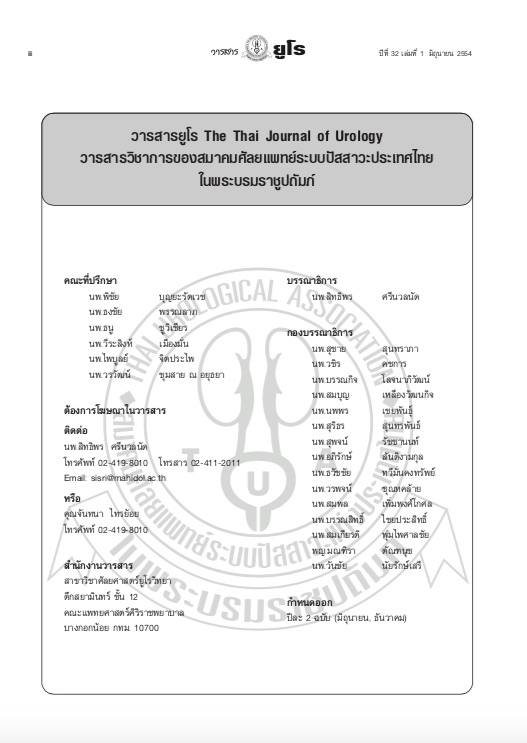Neurogenic Lower Urinary Tract Dysfunction in Pediatric Lumbosacral Myelomeningocele: Urodynamic Classification, Management and Outcome
Keywords:
neurogenic lower urinary tract dysfunction, pediatric, lumbosacral, myelomeningocele, urodynamic, managementAbstract
Objective: To evaluate the lower urinary tract dysfunction of patient with lumbosacral myelomeningocele, management and complications after surgical procedures.
Patients and Methods: Data of 62 myelomeningocele patients (27 males, 35 females) with age ranged from 1-15 years (mean = 5.93 + 3.27) were collected between 1995 and 2009 at Maharaj Nakorn Chiang Mai Hospital. Fifty had lumbosacral region and 12 had sacral region lesions. All patients underwent videourodynamic study.
Result: Results of videourodynamic study were analysed and divided into 2 groups. First group, 48 patients had neurogenic detrusor overactivity(NDO). Of 48 patients, 7 patients had Detrusor sphincter dyssynergia (DSD), and 41 patients had static sphincter activity. Second group, 14 patients had acontractile bladder and static sphincter activity. Of 62 patients, 42 had high risk for upper urinary tract damage due to low compliance (<10 ml/cmH20). Of these,15 had detrusor pressure > 40 cmH20 and 14 had vesicoureteral reflux(VUR) from VCUG study. Twenty had normal bladder compliance. Fourty four patients (33 in group 1(NDO) and 11 in group 2 (Acontractile bladder)) were conservatively treated with clean intermittent catheterization with/without antimuscarinic drugs. Regular follow-up with radiographic investigations and serum creatinine did not changed. Duration of follow-up in this group was 1 to 4 yr (mean 2.18 + 0.81). In surgical group including 18 patients (15 in group 1 and 3 in group 2) underwent various surgical procedures (augmentation gastrocystoplasty with bladder neck reconstruction (Kroppûs technique) in 10, autoaugmentation cystoplasty covered with demucosalized gastric patch with bladder neck recontruction in 4, and autaugmentation cystoplasty covered with demucosalized sigmoid patch with bladder neck recontruction in 4.) In augmentation gastrocystoplasty with bladder neck reconstruction group, 2 were converted to continent catheterizable stoma due to persistent incontinence. In surgical group, 2 had VUR, 1 had renal deterioration postoperatively. Average bladder capacity at Pdet 30 cmH20 pre- and postoperative were 148.05 + 95.32 (range 33-375) cc and 330.36 + 131.06 (range 77-485) cc (p=0.21) respectively. Duration of follow-up in surgical group was 2 to 12 yr (mean 5.85 + 2.98).
Conclusion: The anatomical site of myelomeningocele cannot predict lower urinary tract dysfunctions. Videourodynamics studies have an important role in making proper diagnoses, classifying and assessing the severity of the disease and management. In surgical group; although there was no statistical significance of capacity between preoperation and postoperation, but an improvement of augmented bladder capacity was satisfied.
References
Bauer SB, Hallet M, Khoshbin S, Lebowitz RL, Winston KR, Gibson S, et al. The predictive value of urodynamic evaluation in the newborn with myelodysplasia. JAMA 1984; 252: 650-2.
Bauer SB, Labib KB, Dieppa RA, Retik AB. Urodynamic evaluation in a boy with myelodysplasia and incontinence. Urology 1977; 10: 354-62.
Pontari MA, Keating M, Kelly M, Dyro F, Bauer SB. Retained sacral function in children with high level myelodysplasia. J Urol 1995; 154: 775-7.
Tani S, Yamada S, Knighton RS: Extensibility of the lumbar and sacral cord. Pathophysiology of the tethered spinal cord in cats. J Neurosurg 1987; 66: 116-23.
Dator DP, Hatchett L, Dyro FM, Shefner JM, Bauer SB. Urodynamic dysfunction in walking myelodysplasia children. J Urol 1992; 148: 362-5.
Wyndaele JJ, De SW. Correlation between the findings of a clinical neurological examination and the urodynamic dysfunction in children with myelodysplasia. J Urol 1985; 133: 638-40.
Williams MP, Katz Z, Escala JM, Rickwood AM. Peripheral neurology as a predictor of bladder dysfunction in congenital neuropathic bladder. Br J Urol 1988; 62: 51-3.
Hjalmas K. Micturition in infants and children with normal lower urinary tract. A urodynamic study. Scand J Urol Nephrol Suppl 1976; 37: 1-106.
Koff SA. Estimating bladder capacity in children. Urology 1983; 21: 248.
Abrams P, Cardozo L, Fall M, Griffiths D, Rosier P, Ulmsten U, et al. The standardization of terminology of lower urinary tract function: Report from the standardization sub-committee of the international continence society. Neurourol Urodyn 2002; 21(2): 167-78.
Khoury AE, Hendrick EB, McLorie GA, Kulkarni A., Churchill BM. Occult spinal dysraphism: Clinical and Urodynamic outcome after division of the filum terminale. J Urol 1990; 144: 426-9.
Blaivas J, Chancellor M, editors. Atlas of urodynamics. Baltimore; Williams&wilkins; 1996. p. 150-1.
Landau EH, Churchill BM, Jayanthi VR, Gilmour RF, Steckler RE, McLorie GA, et al. The sensitivity of pressure specific bladder
volume versus total bladder capacity as a measure of bladder storage dysfunction. J Urol 1994; 152: 1578-81.
Ewalt DH, Bauer SB. Pediatric neurourology. Urol Clin North Am 1996; 23: 501-9.
Webb RJ, Griffiths CJ, Ramsden PD, Neal DE. Ambulatory monitoring of bladder pressure in low compliance neurogenic bladder dysfunction. J Urol 1992; 148: 1477-81
Shoukry MS, Ghoniem GM. Effect of time interval and overdistension on repeated urodynamic studies. J Urol 1992; 147: 185-8.
Kessler TM, Lackner J, Kiss G, Rehder P, Madersbacher H. Early proactive management improves upper urinary tract function and reduces the need for surgery in patients with myelomeningocele. Neurourol Urodyn 2006; 25: 758-62.



